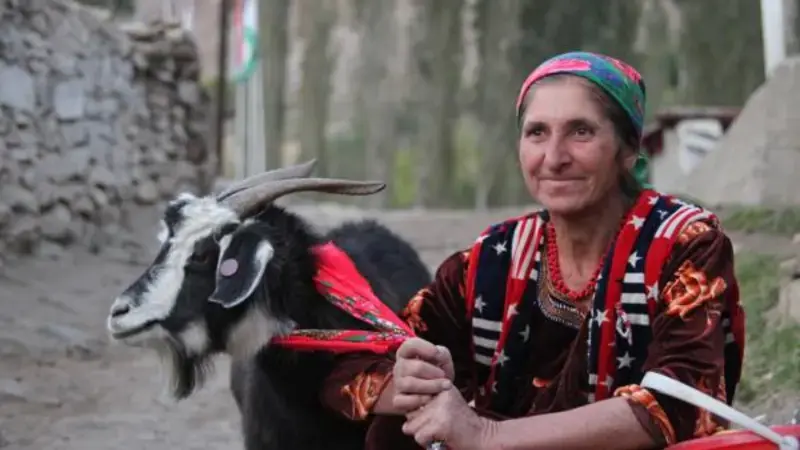Connecting rural women to global markets
Published Date
May 13, 2015

With the help of the project, more efficient processes and higher quality products are generating additional incomes for rural women
In remote regions of Central Asia, where many households depend on goats and sheep for their livelihoods, a harsh climate, poor access to markets, and lack of know-how, limits income-earning opportunities. An ICARDA initiative targeting rural women used a market-driven approach to establish a self-sustaining value chain, from improved breeding and husbandry practices to the production of world-class yarns and appealing products, linked to export markets.
For small producers of sheep and cashmere and angora goats in Tajikistan and Kyrgyzstan, international fiber markets can seem a world away. Local fiber processors – mostly poor rural women – who add value by spinning, weaving, knitting and felting, are equally cut off from these distant markets where handmade, luxury clothing and handicrafts fetch a high price.
Furthermore, the collapse of state-run breeding programs after the breakdown of the Soviet Union has left them without access to new knowledge and training programs to adequately meet market standards.
These conditions pose a serious threat to the sustainability of the yarn sector in a competitive world, and with that, the livelihoods of tens of thousands of families in Central Asia who live in a harsh climate and rely on livestock production as their only source of income.
Breeding animals for higher yields and quality
In 2009, ICARDA began collaborating with small-scale producers in Tajikistan and Kyrgyzstan to establish new breeding programs, using imported genetics and artificial insemination with frozen semen to improve flock quality and yields.
In Tajikistan, angora goats were cross-bred with improved angora sires from Texas to produce a softer, finer fiber and double the mohair yield compared to local goats. A community breeding program for cashgora goats was also established involving over 2,500 farmers from eight villages, using Altai cashmere bucks from Russia, renowned for their higher quality fiber.
The improved cashgora goats produced 15% more fiber compared to local goats, while the percentage of animals producing white fiber (easier to dye) increased by 20%. In Kyrgyzstan, the project improved sheep breeds using high quality Tian-Shan rams, which led to improved wool, along with increased yields of fiber and meat.
Gaining Access to International Markets
To tap into higher-end markets, the project worked with livestock producers to develop a model for processing mohair and cashmere into high quality yarn, suitable for export. The project also worked with spinners and weavers to develop new technologies for processing the yarn into finished products, designed for replication and scaling up.
A major component of the project was enhancing the skills of rural women in spinning, weaving, knitting and felting. Some 23 processing groups involving 257 women gained skills in producing luxury yarns and finished products such as woven blankets and carpets, as well as creating new attractive products for international markets.
The project has opened doors for Tajik suppliers of mohair and cashgora yarn to two US-based companies – ‘Knit Outta the Box’ and ‘Clothroads’ – linking them to buyers in the US and Europe. Products like knitted hats and shawls and felt slippers have also found customers in high end local markets in the West, and are actively sold through the project’s online store, ‘Adventure Yarns’.
Women enjoy greater earnings and empowerment
With the help of the project, more efficient processes and higher quality products are generating additional income, incentivizing all stakeholders along the value chain, many of whom are women. In Badakhshan, Tajikistan, for example, the increased demand among women spinners for combed cashmere has enabled goat keepers – also mainly women – to earn US $21/kg from selling combed cashgora fiber, compared to US $2-3/kg from sheared fiber they sold earlier. The most proficient spinners of mohair yarn can now earn about US $9.40 per day – five times what they earn from low quality yarn produced for the Russian market.
The more lucrative business is motivating rural women to invest their own money in businesses. Many participate in international craft fairs to further market their products. Leaders of the processing groups have also become role models, with the capacity to empower, inspire and teach other women – and men – in fiber processing and business skills.
From Research to Development
The success of community breeding programs and profitable value chains has demonstrated a scalable approach to reducing poverty and food insecurity in remote regions dependent on sheep and goats. The project ended in 2013 and is now being used as a model by development organizations, such as the Aga-Khan Foundation, to replicate value chain development for greater impact in Central Asian countries.
Impact in numbers
• A total of 257 women processors and 148 goat and sheep farmers, owning a total of nearly 10,000 animals, benefited from the project (as of September 2013)
• On average, the annual in¬come of the Kyrgyz women increased by 2.3 times
• The monthly income of Tajik women increased by 1.3 times
